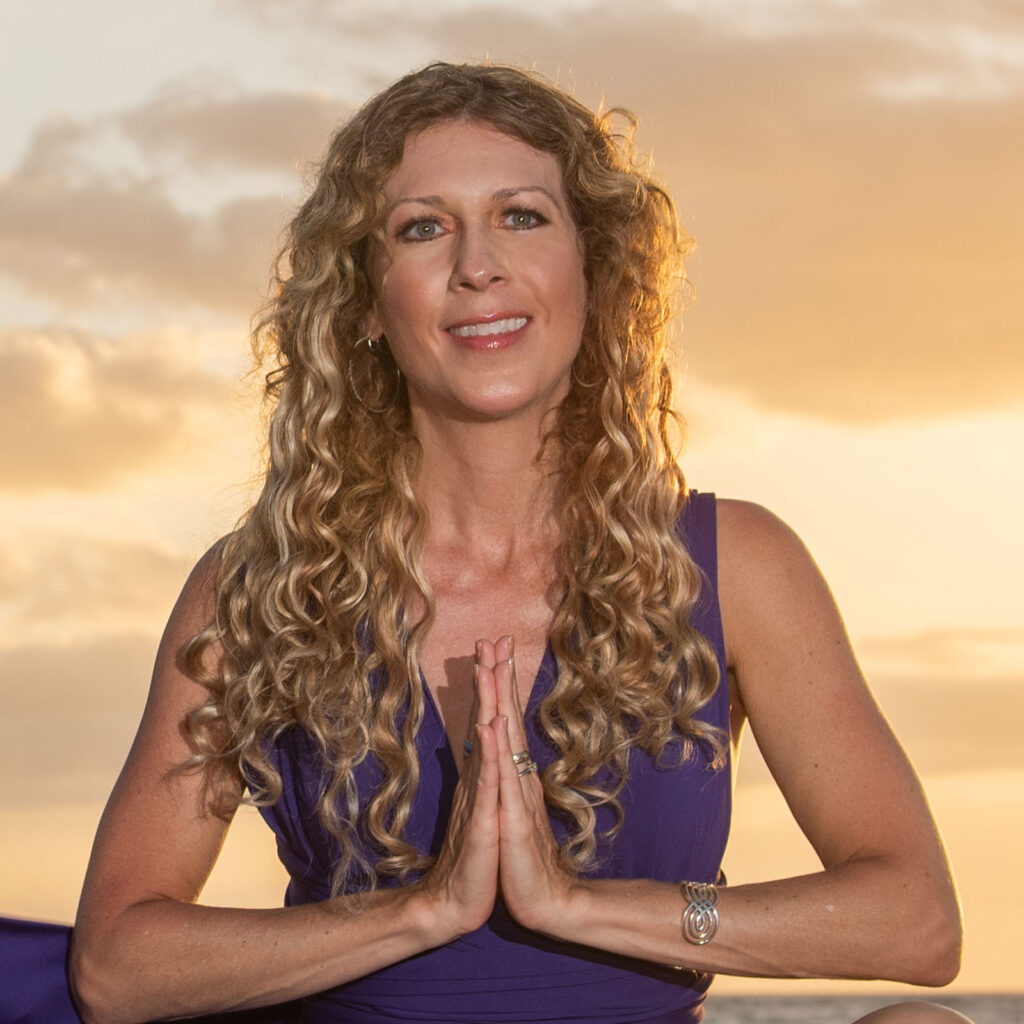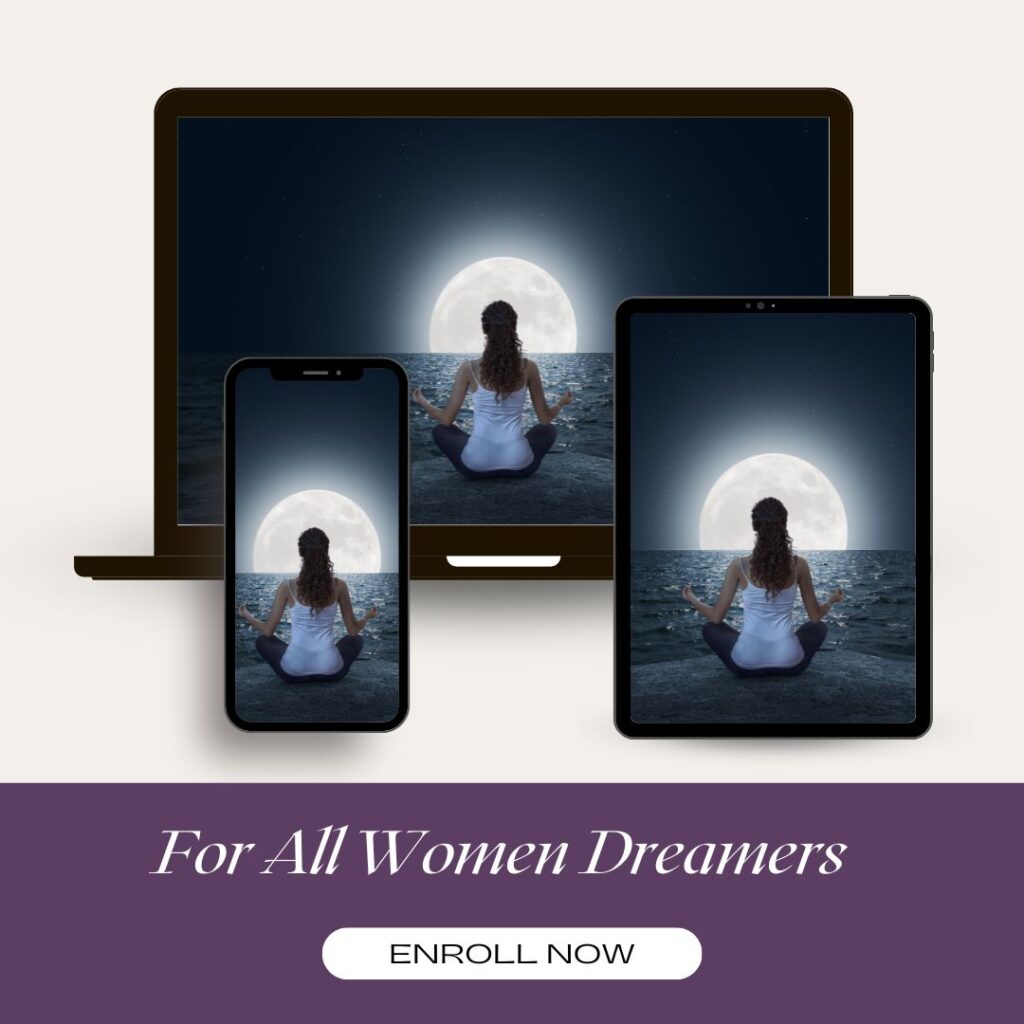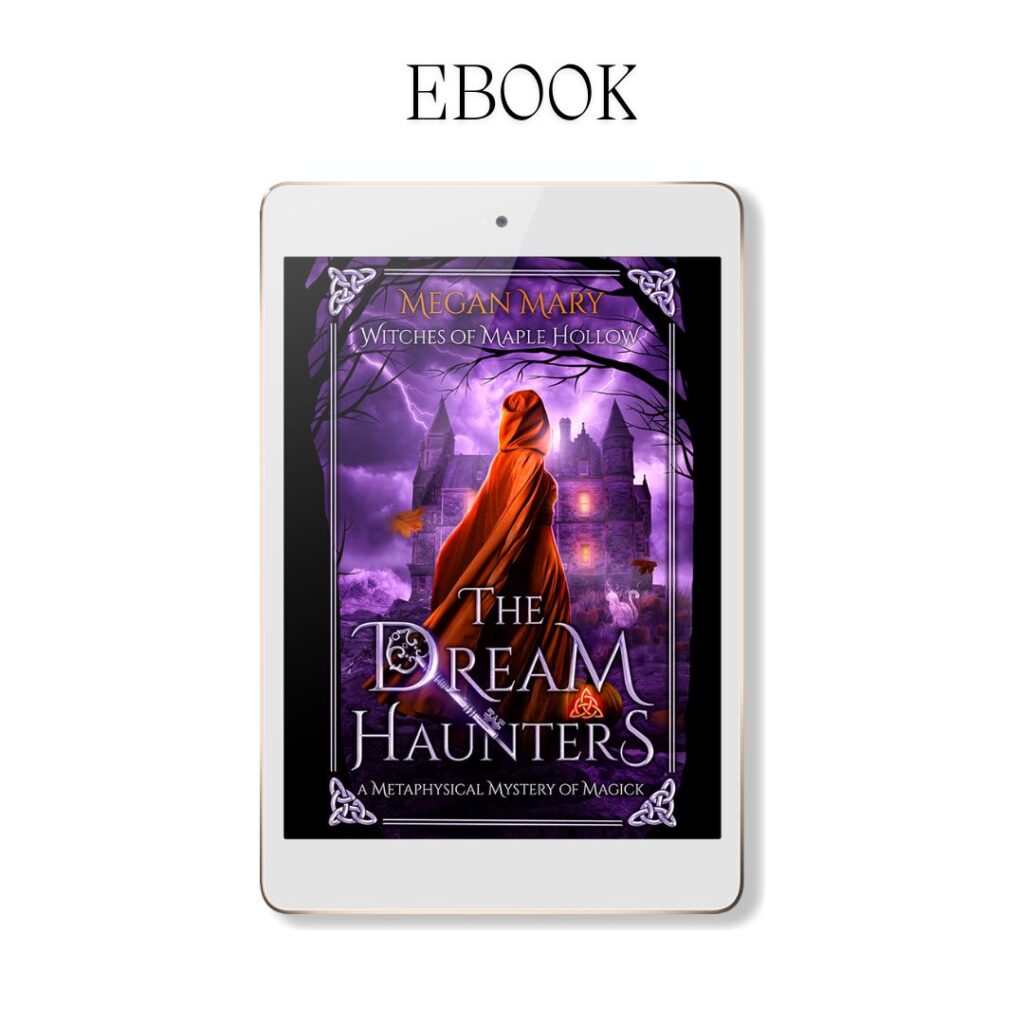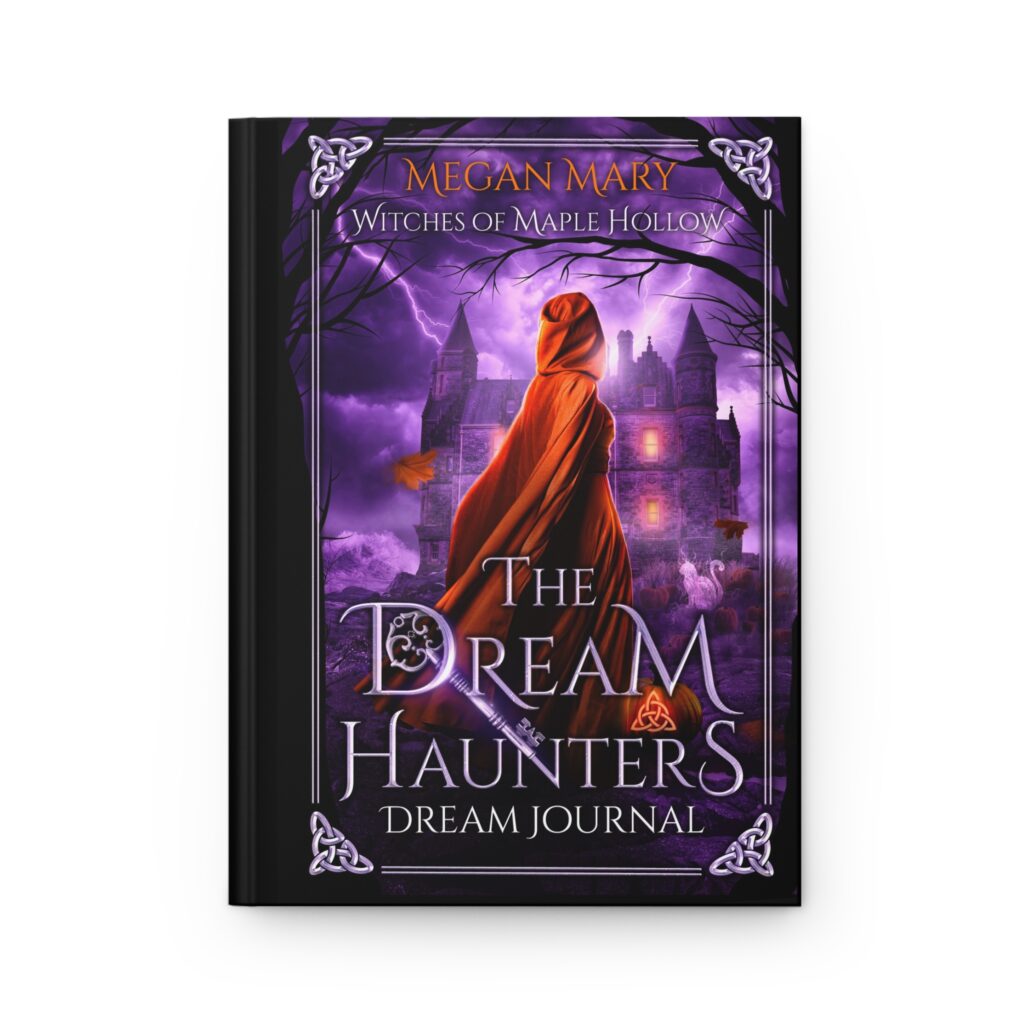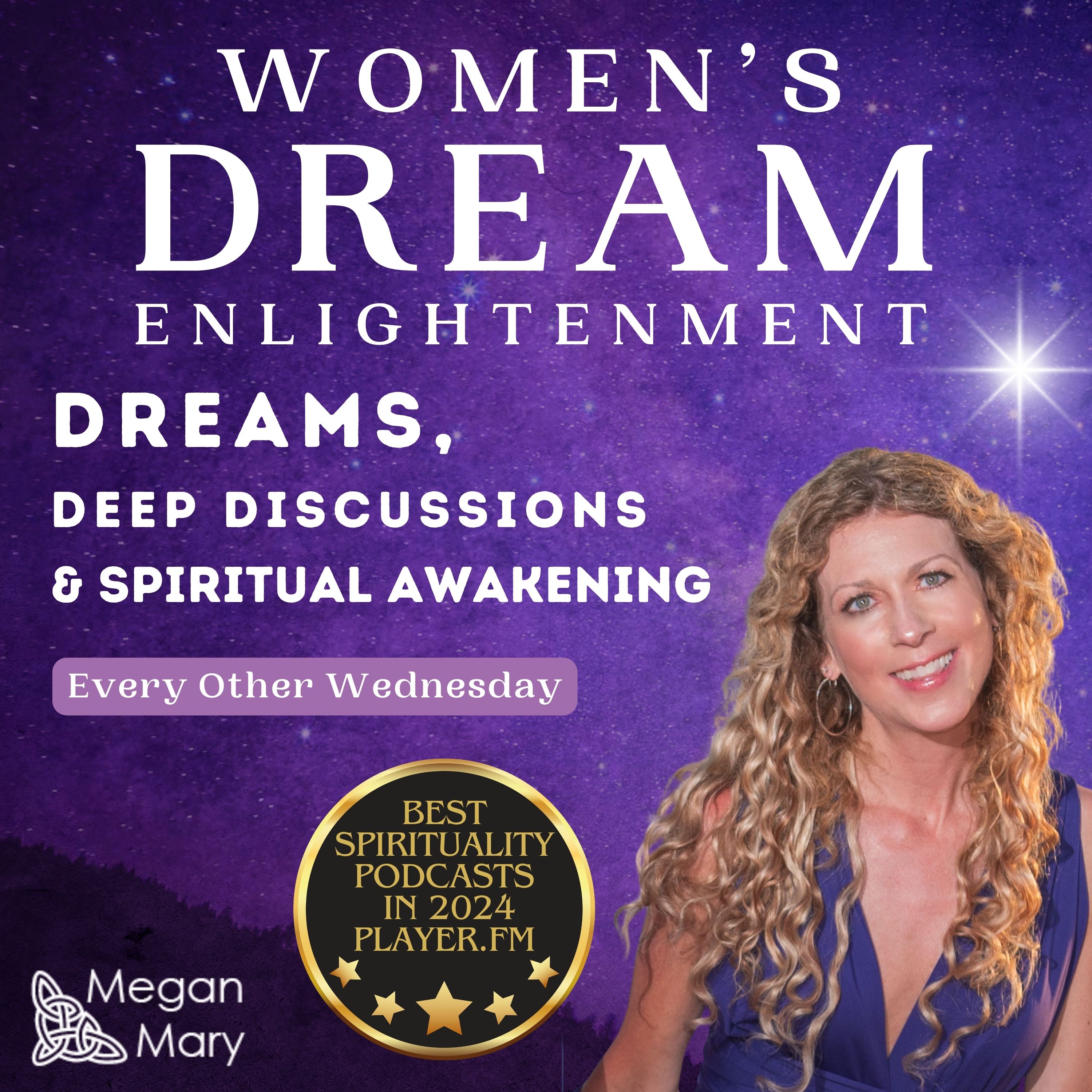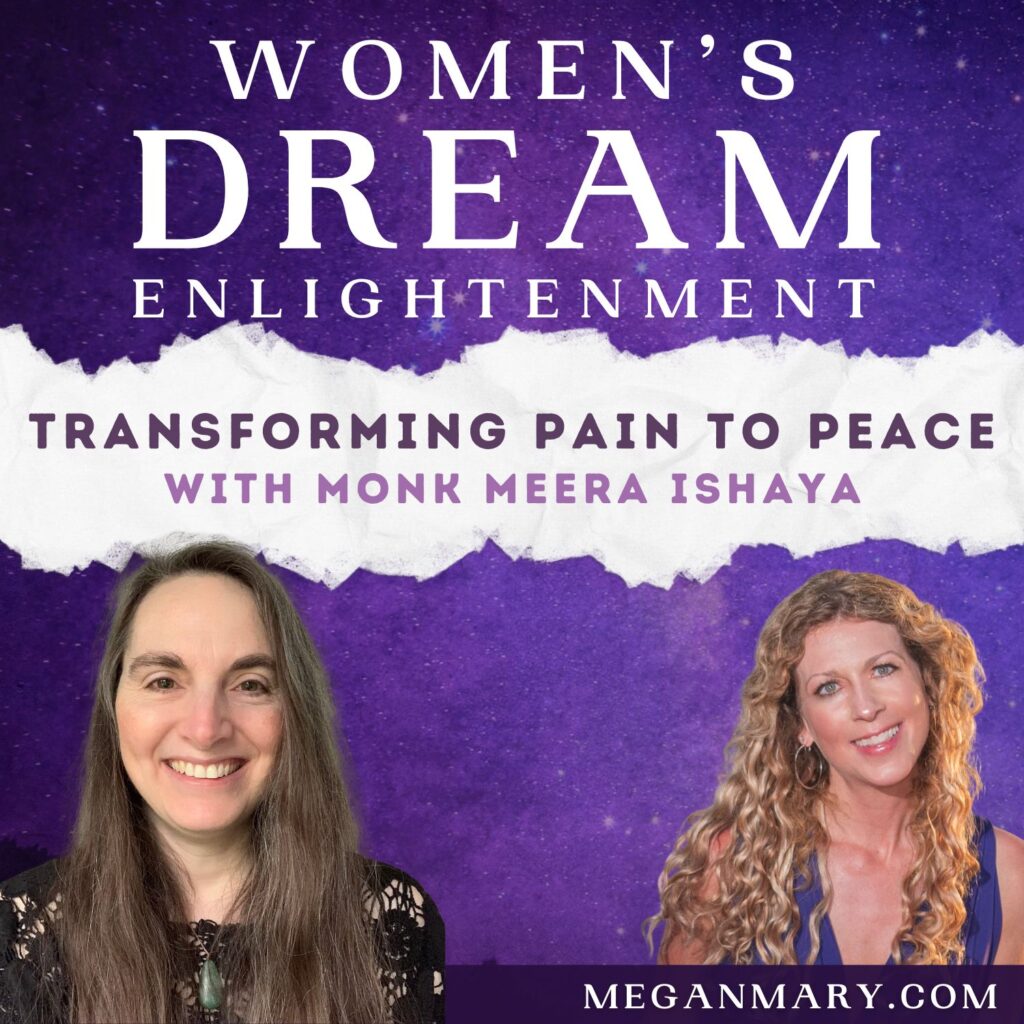
Women’s Dream Enlightenment | Episode 42
Meera is an Ishaya monk, author and meditation teacher who specializes in helping people go beyond the pain label and experience peace, joy, fulfillment and freedom. Peace or pain is a choice and she shows people this is possible and how to make the choice. Surrender is a big part of the process because resistance causes suffering. As an Ishaya monk, the Ascension techniques we practice take you beyond the thinking mind to the direct experience of pure awareness. Meera believes anything is possible and is excited to continue her own exploration to discover what more is available.
Introduction
In my latest podcast episode, I was fortunate to have a profound and enlightening discussion with Meera Ishaya, an Ishaya monk, author, and meditation teacher. Meera specializes in helping people transcend pain and suffering to experience peace, joy, fulfillment, and freedom. Her insights and techniques have empowered many to take control of their lives and find inner peace. Here’s a detailed look at the main points discussed in our conversation.
Meet Meera Ishaya
Meera Ishaya is no ordinary monk; she is a beacon of hope for those seeking to overcome the shackles of pain and suffering. She teaches that peace or pain is a choice, and she guides individuals on how to make that choice. A critical part of her teachings revolves around the concept of surrender, as resistance often leads to suffering.
The Essence of Enlightenment
When asked about enlightenment, Meera provides a perspective filled with depth and simplicity. For her, enlightenment is the recognition of our true nature as pure awareness. It’s not an elusive state reserved for a privileged few but a birthright accessible to everyone. Enlightenment is the state where suffering ceases, and a life filled with joy, peace, and freedom unfolds naturally.
Simple Moments of Magic
Meera beautifully illustrates how moments of magic can occur in everyday life—like the fleeting appearance of a rainbow. These moments are reminders to pause, appreciate, and fully experience the present. She reminds us that the magic of life doesn’t require grand events; it’s available in every moment when we bring our full attention to the present.
The Journey from Pain to Peace
Meera’s personal story is one of relentless physical pain and suffering, leading her to the brink of despair. Despite experiencing chronic pain, which she describes as a tormenting and relentless 10 out of 10, Meera found a turning point. In a moment of extreme desperation, she experienced a profound stillness and peace that propelled her onto a path of healing and enlightenment.
Discovering the Ishaya Techniques
The discovery of the Ishaya’s ascension techniques transformed Meera’s life. These mechanical techniques are designed to bring attention directly to stillness and silence, the essence of pure awareness. They work irrespective of one’s thoughts and beliefs, providing a reliable tool to detach from the thinking mind and experience presence.
Changing the Relationship with Pain
A recurring theme in Meera’s teachings is changing our relationship with pain. Pain, in itself, is a body sensation, but suffering is a secondary, reactionary experience that can be dissolved. By recognizing the resistance to pain and surrendering to pure body sensations, one can move away from the psychological suffering tied to chronic pain.
Practical Applications and Exploration
For those interested in exploring these concepts further, Meera has written two insightful books, *Peace or Pain* and *Surrender is Good for the Soul*. These books guide readers on understanding and applying techniques to change their relationship with pain and suffering. They also offer practical exercises for further exploration.
Conclusion
Meera Ishaya’s journey and teachings offer a powerful testament to the possibility of transcending pain and suffering. Her practical techniques and compassionate guidance remind us that peace and joy are within reach for everyone. To learn more about Meera’s work and explore her transformative techniques, check out her books and reach out via her website.
Special Offer
As part of our podcast episode, Meera is offering a free chapter of ‘Surrender is good for the Soul’, Chapter 27 – The Light of Consciousness, by emailing Meera at info@boundless-meditation.co.uk and quoting ‘DreamChapter27TLOC.
Listen and subscribe on Apple Podcasts, Spotify, Stitcher, iHeart, Pandora, Amazon Music, TuneIn, Podchaser, or on your favorite podcast platform.
Links
Follow Megan
Follow Meera
- Website
- Peace or Pain Facebook Group
- Peace or Pain Telegram Group
- Books on Amazon:
[00:00:00] You’re listening to Women’s Dream Enlightenment. Dream decoding, deep discussions, and spiritual stories of self discovery to inspire your personal enlightened journey. I’m your host, Megan Mary, founder of Women’s Dream Analysis. Let’s bring in the light.
Megan Mary: Welcome. Today we have Meera Ishaya. Meera is an Ishaya monk, author, and meditation teacher who specializes in helping people go beyond the pain label and experience peace, joy, fulfillment, and freedom. Peace or pain is a choice and she shows people this is possible and how to make the choice. Surrender is a big part of the process [00:01:00] because resistance causes suffering.
As an Ishaya monk, the ascension techniques she practices take her beyond the thinking mind to the direct experience of pure awareness. Meera believes anything is possible and is excited to continue her own exploration to discover what more is available. Thank you for being here today, Meera.
Meera Ishaya: Thank you for having me, Megan.
It’s lovely to be here.
Megan Mary: Yes, I can’t wait to share your perspectives on pain and suffering and how everyone can use your techniques to overcome them and live a more fulfilling life.
Meera Ishaya: Yeah. Well, I mean, I’m looking forward to our conversation. Yes.
Megan Mary: So the first question that I ask everybody is what does enlightenment mean to you?
Meera Ishaya: Yeah. And I love that question. Actually, I’ve been asked it a few times before, and I probably give a different answer each time, but it’s [00:02:00] kind of along the same lines. For me, enlightenment is, is the point of being alive, you know to actually be fully aware of who and what we are as pure awareness.
Yeah. And to go beyond the thinking mind and have that direct experience of presence, that’s the purpose of being alive. And then life is one lived of joy and happiness and peace and freedom. But naturally, not anything that we have to strive or search for. And enlightenment for me is actually the natural state of being of everybody.
It’s not this. High goal, if you like, for people who maybe meditate for hours on end in a cave in the Himalayas. For me, enlightenment is the birthright of every single person on this planet, and it’s accessible for every single person on this planet, and it’s accessible now. It’s not this process.
that we have to go through to have the experience of self, we’re just very addicted and [00:03:00] identified with the thinking mind. So we believe that that’s who and what we are. And enlightenment is recognizing that we are more than that, that we are the presence that is aware of the thoughts, aware of the emotions, aware of the body sensations, and that actually even the physical body, you know, exists within our conscious awareness.
So for me, enlightenment is an important topic, and it’s important because a lot of people don’t realise what’s possible. They’re these lofty goals that feels like it’s maybe for some people, but not for them. And , for me, enlightenment is when all suffering ends, and like I say, that’s everyone’s birthright.
And I want to help people to have that experience. And I’m also for me, the way I do that is through my own experience. It’s, it’s an inside out job. And in order to help other people, I need to first be having that experience. For myself, I’m not saying I’m enlightened, by the way,
Megan Mary: [00:04:00] I love how you explain that, that everyone has it within themselves and it’s not this lofty thing that’s only accessible by some and the way we can access it is already available to us.
We just need to learn how and be open. To that extent.
Meera Ishaya: Yeah. And it’s just a, it’s a remembering really, you know, unlearning all of the habits that we picked up or the identification with the mind so that we can actually recognize who and what we are beyond that . So who, who are we when the mind is still?
There are moments when the mind is still and then we are just, there’s just a presence there. There’s just witnessing, there’s just enjoying rather than thinking about, planning about, going to another moment while you’re right here, when you’re thinking you’re in the past or the future and you’re missing what’s right in front of you.
So when there’s moments where a [00:05:00] rainbow appears, we’re just fully attentive, and it feels magical, doesn’t it? But
. It’s not one of those things that we have to have only in isolated moments.
Megan Mary: I love that example because I love rainbows and I do feel like they are magical and I do feel like it’s so fleeting that it asks you, it’s an invitation to just stop whatever you’re doing, observe it.
Because you know it’s going to go away in seconds sometimes and then you can go back to what you were doing but it really is that nature’s intervention almost saying okay just have a moment of stillness and awareness that you’re part of this too.
Meera Ishaya: Imagine having that in every single moment of your waking life.
Megan Mary: That would be amazing.
Meera Ishaya: That we didn’t have to wait for a rainbow to appear or to go on holiday to have that unbroken experience of [00:06:00] stillness. That’s the magic. That’s where everything comes alive. That’s where we have a completely different experience. which is pure, and that it’s the pure experience that is, enjoyable, because we’re no longer beholden to what the mind is telling us.
Because otherwise, when we’re thinking we are literally, it’s like having a virtual reality headset on and you’re experiencing every single moment of life. Through what your thoughts are telling you, like a thought created reality, that’s why sometimes people refer to it as an illusion, life is an illusion and, and I think that can sound scary sometimes.
But, to have the pure experience of something, which we do in moments, like when a rainbow appears or we go to the beach and we sit down for a moment and everything’s lovely and it’s like we’re on holiday. So we’re having a nice time, but it’s actually because we’re just stopping for a moment.
We’re pausing and we’re paying more attention. And, to be able to retrain your attention. So that’s second nature. So you haven’t got to [00:07:00] have a holiday or have a rainbow appear for you to be able to have that level of attentiveness. It’s natural to be witnessing and enjoying every moment.
Megan Mary: Well, I’m curious and I’m sure my listeners are how we can extend that. How do we attain what you’re talking about? So let’s go back and tell. your story of how you came to understand everything in this manner and what did you go through that brought you to this awareness of what you’ve been explaining?
Meera Ishaya: Yeah, I think for me, desperation brought me onto the path of searching. I was in so much physical pain long term chronic pain. And when I say pain, it’s like, 10 out of 10 doesn’t quite describe it. And it was relentless. It was every single moment of, of every single day. And it was really difficult to have [00:08:00] conversations, because it’s just like this screaming experience that, there’s just, there’s See, no point to have these banal conversations with people, that everybody was making so many things important.
And yet I was just having this horrible experience of pain and immobility as well. So there’s been various times when I haven’t been able to walk at all. And never knowing when that would arise and never knowing if I’d ever get past that. So for me the turning point was when I didn’t want to live anymore.
I got to the point where I can’t do this anymore. This is not living. And in choosing to not live anymore I stopped for a moment. That moment, pausing, I had a knife in my hand. I was going to use it to cut myself. And in that moment, everything stood still. Time stood still. This beautiful experience opened up for me because I was actually paying attention.
And in that moment, it gave [00:09:00] me a taste of what was possible, and it was a really beautiful, full, rich experience, which, had a very lasting impression on me. And so that became the turning point where I thought, well, In like, this is my worst moment of my entire life and I can have this experience you might call it transcendent experience.
I now know that it’s really not, it’s quite a very simple, pure experience that I can access very readily and easily now. And so in having that experience for me, it was huge because my life had been so full of stress, of anxiety, of depression, of pain, suffering. It was, it was a tormenting experience, actually.
And so having this experience that showed me what else was possible, and it was possible in the blink of an eye, from absolute agony to extreme peace and beauty and [00:10:00] expansion and peace, endless peace, so I’m right. Okay. Hit the reset button. How do I get that? That has got my attention.
That is worth living for. That is, that is what I want. Don’t know what it is. Don’t know how to get it again. Cause it obviously faded. But I knew I wanted it. And, and then I was so one pointed on, on that. Within that, part of that journey was helping myself, healing myself. Okay. Getting out of pain, being able to have more mobility.
So there were some practical things that I did in order to have that happen. But it was like with this one pointedness for wanting this experience again, it was that life started to provide opportunities, provide solutions, options. And shortly after that, I found, or they found me, the Ishayas, the Bright Path Ishayas, came across my path.
in the form of a book that I was lent from [00:11:00] another participant from lots of different workshops that I was going to in my, my search to uncover this experience, to access this experience and, and replicate it in my everyday life. And, and all the other workshops have been wonderful, but when I found the Ishayas, I was, it’s like, I was home.
I’m like, that’s it, almost job done, but here is where the adventure begins. You know, I don’t need anything more than this, although life is a playground. So there are so many different tools and techniques and fun to be had and ways to make our life easier and more fun and more enjoyable and more fulfilling.
And for me, the foundation of all of that is, is presence. And the Bright Path Ishayas taught me some techniques called Ascension Attitudes. And the Ascension Attitudes the tool that started to retrain my experience back onto that, that stillness. [00:12:00] And they’re mechanical, so every single time you use them, boom, you’re there.
And then we kind of contract back down and go into the thinking mind again. And then we use the technique, which is almost like a thought that replaces the other thoughts. and brings us directly to that experience of stillness. And so just like going to the gym for the awareness muscle, I would use the techniques, go back into thinking, use the techniques and start to stabilize and have a more direct conscious awareness of this experience of stillness.
So, but for me, It’s this ongoing adventure, it’s not like job done, but here is where now I can live now I can have a fulfilling life and I can help others do the same. Transcend pain transcend suffering and actually live actually do what we’re here to do and and connect and and be kind to each other.
Megan Mary: That is such a powerful story. [00:13:00] And I love how you. Mention just the universe providing opportunities, and I really resonate with that very strongly. I feel so many of us go through so much suffering and so much trauma and so much difficulty in whatever area it might be in our life. And it doesn’t really seem like there’s a point or purpose to that.
But really, sometimes that silver lining is when we really can get to that bottom spot. And then there is nowhere else to go but up and through that experience is how we really start to step in to alignment with so much more that we didn’t have the capacity to realize before. And so that’s.
Really powerful. And I also, want to hear more about how , the ascension attitudes, but also how it’s mechanical in [00:14:00] nature. I’d love to just hear a little bit more about how it actually works.
Meera Ishaya: Yeah, sure. So we often call ascension as more than meditation. It’s a more comprehensive technique structured in such a way that it brings your attention directly onto stillness and silence, which is the context, the backdrop to all the sound and all the movement in life.
So for me, a lot of meditation techniques are amazing and like mindfulness, it brings us present. But it doesn’t necessarily bring us aware of presence, of awareness, of stillness and silence. And those words are all one and the same thing. Pure awareness is what we are. That which is looking at through your eyes right now is that pure unbroken awareness.
It’s unmoving and unchanging. And we might say that is stillness, that is silence. So when we notice stillness, we’re noticing ourselves. We’re not going somewhere else in our experience, we’re actually showing up in this moment and being here [00:15:00] now when we’re aware of stillness and that is presence, that’s who and what we are.
So mechanical simply means that they work 100 percent of the time regardless of what the subjective experience is and regardless of what we think, what we believe. Belief doesn’t prevent it from happening because they are mechanical. It’s an automatic opening up into that awareness. And all you need to do is use the techniques and within that experience, stressful, everything that we’re holding onto, everything that we’ve taken on board, that does not serve us right here, right now, dissolves very naturally and very easily.
So that’s the mechanical aspect of the technique is it does the job, no matter what we think about it, no matter what we feel about the experience of it. A lot of that is learning to be okay with the experience when it’s not okay, because as stress is released, we are very well trained at putting our [00:16:00] attention on the content of thought, of emotion and body sensations.
And so when that is releasing, if all of our attention is on it, it’s a very intense experience. It could be painful, it could be uncomfortable and it’s certainly distracting . So some people go, I don’t like that experience. That’s why we provide ongoing guidance so that people can get really clear and get the benefit out of these techniques because they work.
They’re incredibly powerful. And that can be a little bit unnerving for somebody, , you have the amazing experience of stillness and then the next thing is like you’re just thinking and thoughts are the exhaust fumes of healing and so we’re working with the natural tendencies because it’s a mechanical technique, so that the natural tendency of the mind is to seek joy.
And that’s what it’s always trying to do. That’s what it’s thinking. It’s thinking round and round and round and round and round this moment. And it’s, the joy is here now. So the technique provides the mind exactly what it wants [00:17:00] this moment, which is joyful, ? And then the body’s natural tendency is to heal.
And so when we allow our minds to still from using the technique, automatic stillness, because of the mechanical nature and structure of the techniques. And then that allows the body to still as well because of the mind body connection. And so because of the natural tendency of the body is to heal, movement happens.
Healing is movement. And so that creates activity in the mind. So thoughts are okay. Thoughts are part of the process. Thoughts are just exhaust fumes of healing happening. And yet we latch onto them , and we do that linear thinking, which is Really just like listening to a radio station, our attention isn’t here now, it’s, it’s on another moment, on an idea, on a concept, rather than experiencing this moment in its fullness.
Megan Mary: So it sounds like we don’t really need to worry about trying to remove the active mind. [00:18:00] That it’s okay that we are maybe on this hamster wheel but that we use the technique and then it just releases us from that loop without efforting.
Meera Ishaya: Absolutely. No effort is required. And one of the things that we’ve, we help with our ongoing guidance is we will put effort in. We’re very well trained at and often we use the word efforting, you know, we, we put effort in, we strain, we try, we struggle, we battle with life, and, and that’s what the thinking mind does. It’s forceful, it’s trying to force an outcome.
Okay. It’s trying to make things happen rather than to actually access that flow of almost what I might call the river of grace. Everything, all good is coming to us always, but if we’re thinking we might not recognize something, we might actually think something’s bad. Because it’s distorted by the thoughts.
We’re seeing what we’re [00:19:00] expecting to see rather than what’s actually happening. And the same goes for hearing and experiencing all of our senses. Actually, there’s a distortion that happens when thinking is governing our experience.
Megan Mary: You had mentioned suffering is really the problem.
It’s not the pain, it’s the suffering that we experience as a result of the pain. And for anybody who is listening that suffers from chronic pain or any kind of physical pain, how can these methods be applied to that, to release that, to relieve that?
Meera Ishaya: For me These techniques have been the foundation for me changing my relationship with pain in purifying the experience.
So you’re bringing it back to just a body sensation, rather than a story wrapped around a body sensation. So that which I would call pain, which is really suffering, it’s a secondary experience, is a reaction to what is happening. We are resisting we are [00:20:00] wanting the experience gone, but The experience that we got, we want gone is already a distortion.
We were resisting way before it became even slightly uncomfortable. And so it’s that resistance that increases the intensity of something. As it increases intensity, it gets to a certain threshold. And then we might label it as pain. It’s painful now. And what I’ve recognized through using the ascension techniques is to giving much more clarity and alertness.
So now I can see the thoughts surrounding the experience. I can see how there’s like this downward spiraling that happens. And when I do that, I’m resisting the body sensations, and then the intensity increases and I experience pain. And so for me, now, the majority of the time, I don’t experience any pain.
I don’t even experience a discomfort with other symptoms I might have. For example, I have asthma. It doesn’t tend to affect me so much anymore. I, I recognize when my body, there’s a [00:21:00] tightness in my chest. I use my medication and, but there’s no suffering. There’s no dialogue about it. There’s just the steps that are needed to be taken to enable me to continue breathing.
But actually using the techniques sometimes will actually relieve my breathing without needing to use the medication. So that’s where I get really fascinated because I’m like, what is possible? And the first way I recognized that was when I picked up my inhaler to use it one time. I could breathe again.
Hadn’t actually used it. I just picked it up and I’m like, whoa, what just happened? So I explore these little things. I don’t just sort of brush it off. I go, right, what’s happening in that moment? How, has , my breathing suddenly relieved? I haven’t even used the medication. And it’s because I knew I was going to get it.
So I stopped the resisting stop. So my body just went, ah, I can breathe again. And that’s
fascinating. Yeah, my words. Exactly. And the same
happens for physical pain. I’m
Megan Mary: intrigued. [00:22:00] Yes. And I think everybody else is probably too, because see what you’re saying, especially when you suffer with chronic pain, you’ve struggled with it for so long.
And you have all of these mental and emotional, I’ll just call it baggage, attached to that condition and that pain. And when it starts to increase, you do resist because you feel like, not this again. And your whole mental state is destroyed. Like you said, distracted by it and you really can’t think about anything or concentrate on anything except that pain.
It’s so enveloping and you also emotionally you think that you’re trying to deal with it, quote unquote, but you’re actually resisting it because you don’t want to deal with it.
Meera Ishaya: And obviously we don’t. No, I’m not ever [00:23:00] expecting anybody to, to want to accept pain in, but what I do guide people to, to do is to start to become aware of the body without the mind’s involvement.
And that does require guidance, I think, to start with, because we aren’t recognizing all those little ways. Like, we identify with thoughts. When we identify with them, we don’t see them. The thoughts that you see are the surface layer of thoughts. But underlying that, there’ll be thoughts that you identify with that you actually think is you.
And so that muddies the waters. It prevents us from seeing the mechanism of pain and how it’s playing out and what part we are playing in that. And for my long term chronic pain it took me a few years, but I got to the point where I wasn’t in pain anymore. But I also explored with it when I had broken ribs.
So now I have actual physical damage in the body because a lot of the long term chronic pain, there wasn’t anything wrong with me as such. I had a condition, but a [00:24:00] lot of the time there wasn’t really anything going on that could, anything could be done about it, doctors often come up with reasons for why you have pain, but whether that’s actually accurate or not, or whether it’s a stab in the dark is another matter, which, you want to follow what your physician says, but at the same time, you want to get curious and explore what is actually possible within this.
And so when I have broken ribs, I’m like, well, so, okay, I’ve got broken ribs. Do I have to suffer for through the next five or six weeks till it heals? And so I started playing with the same techniques with the capacity I had to be able to be more alert and attentive now. And there were times when I slipped into a completely different operating mode and there was no pain, there was no suffering, and there was more ease of movement.
That’s the crazy thing. Like when I was in the suffering mode and I needed to go and get a drink, it was a bit like, oh, like you get winded through broken ribs and it’s a bit, you know, really carefully and slowly, getting the drink. When I was completely surrendered. [00:25:00] And accepting and allowing, in my experience, I could lean forward smoothly, get the drink, no winding, no stab of pain, everything was easier and more fluid, so, yeah.
And that was just through me exploring what was possible, nobody guided me to that experience, nobody pointed me in the right direction of whether that was even a possibility or not. So, yeah, again, I’m constantly fascinated to see what is possible and, and help others explore in their own experience so they can get the best quality of life.
Megan Mary: Yes. And I love that you particularly really focus on helping other women with that because So many women suffer with so many chronic illnesses or conditions or painful situations that are unique to them. And they just get stuck in this loop of suffering and don’t really know how to get out [00:26:00] and need that empowerment pathway that says, actually, , just try this.
There’s no, there’s no risk in trying it. And it can actually really. Lead you to be able to help yourself in a way that you probably didn’t think was possible.
Meera Ishaya: Absolutely. And pain does not happen in isolation, people uncover all these aspects of their life and how they’re approaching it, which gives a completely different experience,
for me, I love that because I’m empowering people, to have a completely different experience across the board, every aspect of their lives, with their relationships, with their emotions, with their job, with their family, whatever that is, there’s a greater experience to be had,
and so for me, pain has been a blessing. Which, I know my mum always thinks I’m crazy saying that I’m so glad I’ve had the experiences that I’ve had. They’ve all led to where I am now, so I wouldn’t want to have not had any of them. Especially as it’s taken me to the point where, [00:27:00] if something happens now that is painful, I don’t instantly go into resistance, or if I see some resistance, it doesn’t stick, because I’m so well practiced now.
Two as well, to be able to help other people, it can sound a noble thing, but the, the joy within me, when someone comes to me and within an hour, they recognized and can choose for a completely different experience, and they’re like absolutely gobsmacked typically, they come really stressed, really.
in pain, whether it’s mental, emotional or physical and they don’t see a way out. And I show them within an hour that there is a way out, that’s like the best job in the world, .
Megan Mary: Absolutely.
Meera Ishaya: Isn’t it? So I absolutely love it. And that’s why I’m coming on podcast because I want to be able to reach more people.
I want people to know that there is a choice here. , and it’s a very easy one to make once you know how.
Megan Mary: So for someone wanting to do this, [00:28:00] what steps can they take in that direction?
Meera Ishaya: Well, I mean, that’s one of the reasons why I wrote the books that I’ve written, Peace or Pain, and Surrender is Good for the Soul.
So that’s the first step that somebody can do, and then they can get to know me. The first part of my Peace or Pain book is my story. So people can understand what I’ve gone through and how I, got to where I am now, or where I was two years ago when the book was published. And then it, it talks about understanding pain, some of it’s scientific, but an awful lot of it is from my own understanding, my own experience, which is replicatable with everybody that I’ve worked with.
There’s always, there’s always a way that. Sometimes I have to use different techniques, different approaches with some people, but more and more I’m finding actually that it’s very simple and easy. I think as my experience has become simpler and easier. It’s easier for me to help other people than it was two years ago, for example.
And then there’s a part of the book that highlights all the different ways that you can begin to approach and explore changing your relationship with [00:29:00] pain. So, so that you can come away from the suffering aspect of it. You can come away from the story, the intensity and the pressure and have a more pure, clear experience of your body symptoms and sensations, which are typically.
You can let them be there or not be there. They’re not a bother to you anymore when it’s a pure experience. And then the last part of the book has some exercises so people can start to apply it further and actually experience it, actually start to make those, those positive changes. And, and not just with pain, but with other areas of your life too.
And that’s why it led into the other book, Surrender is Good for the Soul, because, , we suffer because we resist. Resistance is the cause of suffering. Always. And it’s crazy because it really appears to be something causing our suffering. But as you start to unravel the pattern, you start to raise your level of alertness through using a meditation technique, particularly the ascension techniques are very successful at doing that.
Then the resistance falls away [00:30:00] and then you have a completely different experience. And, and we don’t recognize all the ways we resist all the ways that we distort the experience and we battle against life. So that’s why I wanted to write a book that helps people to see all of the different ways and apply it, then lots of practical help to be able to apply it in their everyday lives.
So that’s my first port of call for people, but then people do one to one sessions with me and I do online and in person courses as well. So people can actually start to explore this concept, understand theoretically, and then also experientially put it into practice. I combine the both. You need both.
You need the theoretical understanding and the tools to experience it for yourself.
Megan Mary: Well, that’s wonderful. And actually as part of this episode, you’re going to be offering a free chapter from your book. And so check the show notes for that. I definitely looking forward to that myself. I can’t wait to dive in and and really find [00:31:00] out how this works.
So where can people find you if they want to contact you?
Meera Ishaya: Yeah, so I’ve got a website called boundless meditation. co. uk so that’s probably the best place as links to my books, which were available on Amazon there. And then the courses that I’m providing and the contact details. If you want to email me or call me,
To, to talk about your experience and see what’s possible for you.
Megan Mary: All right. Well, thank you so much for being here today, Meera. I truly appreciate you sharing your personal story and your mission now and everything, all the work that you’re doing to help other women is just wonderful. Thank you so much.
Meera Ishaya: No, thanks for having me, Megan. It’s been lovely. I really enjoy chatting with you always.
Thank you.
Thank you for listening. Did you enjoy this episode? You can now send me a text message and share your experience. Be sure to [00:32:00] subscribe to make sure you never miss an episode. Head over to my YouTube channel. and hit that subscribe button as well to be part of my growing community. Are you ready to take the next step in your spiritual journey?
Don’t miss out on the new Dream Empowerment Programs, unique opportunities for you to unlock your inner wisdom, discover your authenticity, align with your higher self, and bring abundance into your life. If you’d like your dream or awakening story. Featured on my show. Submit it today. Your dreams have the power to inspire and enlighten other women on their journey.
Visit meganmary.com to find out more.
[00:33:00]




